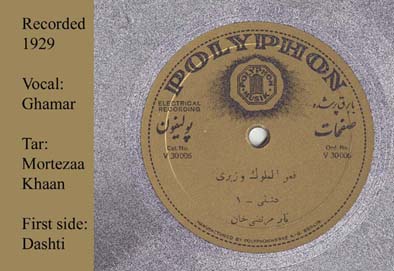|
Persian Classical Music
Musighi-ye
Dastgaahi-ye Iran

The
DoveSong.com in cooperation with the Nassehpoor Family of
Tehran is pleased to provide all peoples of the world with this
page of important and rare Persian Art Music. For the first time, these
great treasures of Persian Art Music are being made available,
transcribed to MP3 format by Pooyan Nassehpoor from very rare
recordings.
Together
the DoveSong.com and the Nassehpoor Family dedicate this
page to our brothers and sisters in all lands,
that may we learn to love and understand each other through an
understanding of our music and culture.
#1:
Zelli
(Aavaaz-e Abu'ataa)
Rezaa-Gholi
Mirzaa-Zelli (1906 – 1945), vocalist and master of Persian
radif repertoire was one of the best masters of Persian vocal
music. He studied Persian vocal music under the training of
Abol-Hassan Eghbaal (one of the greatest masters of Persian
vocal music) and Aaref Ghazvini (social activist and one of the
greatest tasnif composers in Iran). Zelli played concerts and
recorded some pieces of his voice accompanied by
instrumentalists such as Moshir-Homaayun Shahrdaar (pianist),
Abol-Hassan Sabaa (violin). He passed away at the age of 38.
#2:
Zarpanje
(Da stgaah-e Maahur)
Yahyaa
(Haarun) Zarpanje, Jewish tar player, was born in Tehran, Iran
(Persia), about 1897. His father, Rabi’ was a singer and
daayere (Persian frame drum) player. His brother, Musaa, was
also tar player. Yahyaa started playing tar during his
childhood with his brother, Musaa, and then he became the
student of the very famous tar and setar player, Darvish Khaan
and Aaghaa Hossein-Gholi, the greatest tar player and master
of radif repertoire. He was called Yahyaa Kolang (Kolang
literally means pick!) by Darvish Khaan because his tar
plectrums were very strong and powerful. Yahyaa Zarpanje was very serious
practicing tar and everyday he used to play
for many hours. He made some trips to Esfahaan, Rasht and
Shiraaz (some important cities of Iran) and performed some concerts
there, and people loved his music. Fortunately, he recorded
some of his tar pieces on gramophone disks. He passed away at
the age of 35.
#3
- Haaig
(Aavaaz-e Esfahaan first side)
#4 - Haaig
(Aavaaz-e Esfahaan second side)
Haaig is an Armenian Kamaanche player and in
this recording Saashaa Taarkhaaniyaan has
accompanied him with Armenian tar on the first side. It is guessed that this
record was recorded in the 1930's.
#5
- Ghamar
(Aavaaz-e Abu'ataa, Daraamad)
#6 - Ghamar
(Aavaaz-e Abu'ataa, Hejaaz)
Ghamar-ol-Moluk
Vaziri, the most famous vocalist of Persian art music, was
born in 1905. In childhood she lost her mother while her
father had died too, so her grandmother became her guardian.
Her grandmother, Molla-Kheyr-on-Nessaa (titled to
Eftekhaar-oz-Zaakerin), was singer of the Rozekhaani
ceremonies (religious ceremony) and Ghamar accompanied her and
participated in the ceremonies. This was her first
acquaintance with the Persian vocal music of the Rozekhaani
genre. Their house was in the Sangalaj district of Tehran.
When Ghamar's grandmother went to Karbalaa on pilgrimage of
Emaam Hossein's shrine; she stayed at the house of her cousin
(the wife of Majd-os-Sanaaye') where musical gatherings (Mahfel-e-Musighi)
were held, and great masters of Persian music such as Darvish Khaan (very
famous master of tar and setar), Rokn-ed-Din Khaan Mokhtaari
(composer and master of violin), Haaji Khaan Eyn-od-Dole (very
famous master of tonbak) and Shaah-zaadeh Hessaam-os-Saltane
(multi-instrumentalist) were playing. Through this, she became
more acquainted with Persian music and she was invited in
a wedding ceremony where the great master of tar, Mortezaa
Neydaavud was invited too.
When she sang in the wedding
ceremonies privately, Ostaad Neydaavud played tar and asked
her to sing again and she sang again and the Ostaad loved her
voice and invited her to attend his class in order to learn
the radif repertoire of Persian music. She went to his class
and very soon she became one of the best singers of Iran.
Their first concert was at the salon of the Grand Hotel about
1924. Then again their second concert was at the Palace Cinema
located in the Laalezaar Street of Tehran.
So
she became more famous and was acquainted with famous poets
and writers of her time. Gradually she recorded many
gramophone disks and performed many concerts with the tar
of her master and colleague Ostaad Neydaavud and she became
more and more famous. What money that Ghamar earned she shared among
the poor people and when she passed away in August 5, 1959,
she was poor.
Music
by the Nassehpoor Ensemble
Nasrollah
Nassehpoor (Dastgaah-e Maahur)
This piece, tasnif-e Ze Man Negaaram,
was sung by Nasrollah Nasehpoor in 1983 accompanied by Mohammad
Reza Lotfi
(setar) and
Nasser Farhangfar (tonbak). Ze Man Negaaram was
created by Darvish Khaan in "Dastgaah-e Maahur" that
was sung by other vocalists like Ghamar and etc.
Parham
Nassehpoor (Dastgaah-e Chahaargaah)
We would like to make available
contemporary performances. This is a piece performed by Parham
Nassehpoor playing tar and accompanied by Peyman Nasehpour's
tonbak. The rhythm is in six beats.
Pooyan
Nassehpoor Santoor Solo
The
santoor is similar to the hammered dulcimer of the western
world. In this short selection, we hear Pooyan Nassehpoor
accompanied by his brother Peyman playing the tonbak.
|

